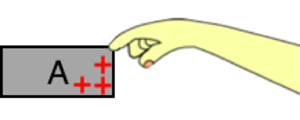Materials can be categorized as being conductors or insulators. Conductors are those materials that allow the free flow of electrons from atom to atom across their surface. Insulators prevent the free flow of such electrons. This property makes the behavior of conductors quite different than that of insulators when they are touched to a charged object or to the ground.
Conductors and Insulators - Questions 1 Help
There are two similar versions of this question. Here is one of the versions:
 Version 1:
Version 1:
Object A is an insulator. It has a positive charge. It is touched to the ground. When the ground is pulled away, what charge does Object A have?
Try these links to The Physics Classroom Tutorial for more help with understanding the process of conductors, insulators, conduction, and grounding. Links to the corresponding videos are also included:
Conductors and Insulators (view Video)
Charging by Conduction (view Video)
Grounding - The Removal of Charge (view Video)